Buzzer의 종류#
| Active Buzzer (능동형 부저) | Passive Buzzer (수동형 부저) |
|---|---|
| 有源蜂鸣器 (KY-012) | 无源蜂鸣器 (KY-006) |
| 회로가 내장되어 있어, 전원만 인가하면 소리가 나므로 프로그램 제어가 편리함 | 내부에 진동원이 없어, 스케치에 주파수를 지정하여야만 소리를 냄 |
| 원하는 주파수의 소리를 낼 수 없음 | 원하는 주파수의 소리를 만들어낼 수 있음 |
| 패시브 부저에 비해 비쌈 (모듈 1개 0.9위안) | 액티브 부저에 비해 저렴 (모듈 1개 0.8위안) |
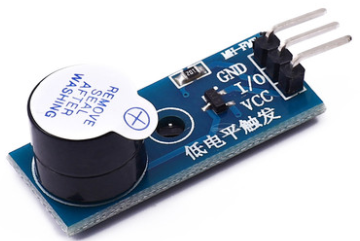 | 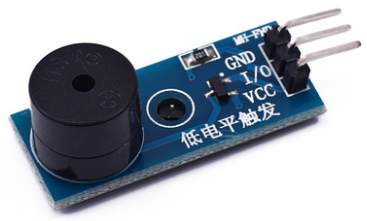 |
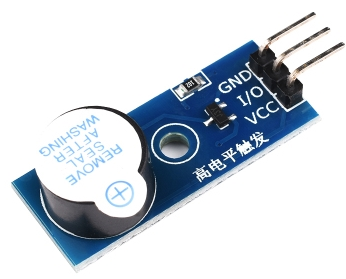 | |
 | |
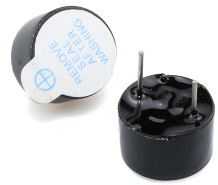 | 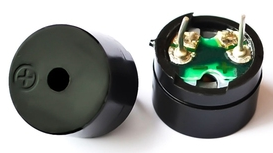 |
- 모듈로 판매하는 제품의 경우 겉모양으로는 구별이 어렵다. Active Buzzer의 경우 초기 판매시 스티커를 붙여서 판매하지만, 스티커가 떨어져 나간 상태라면 Passive Buzzer와 구별하기 어렵다. 또한 반드시 스티커가 붙은 형태로 판매하는 것도 아니다.
- Active Buzzer의 경우 스티커로 사용전압을 표시하기도 한다. 빨간색은 3V, 파란색은 5V, 보라색은 12V용이다.
- Active Buzzer 모듈의 경우 低电平触发(혹은 Low Level) / 高电平触发(혹은 High Level) 2가지 형태로 표기가 되어 있다. 低电平触发은 DigitalWrite에서 HIGH일 때 소리가 나며, 高电平触发은 LOW일 때 소리가 난다.
- 모듈 형태가 아닌 단일 부품의 형태라면 연결 핀이 나와 있는 아랫면을 보면 구별할 수 있다. 일반적으로 Active Buzzer는 검은색 실리콘으로 밀폐되어 있으며, Passive Buzzer는 핀의 접합부위가 그대로 노출되어 있다.
- Active Buzzer와 Passive Buzzer를 구별하는 가장 좋은 방법은 사용전압에 해당하는 전압(낮은 전압의 건전지도 가능)의 건전지를 연결시켜보는 것이다. 소리가 나면 Active, 나지 않으면 Passive라고 생각하면 된다.
Active Buzzer#
schematic#
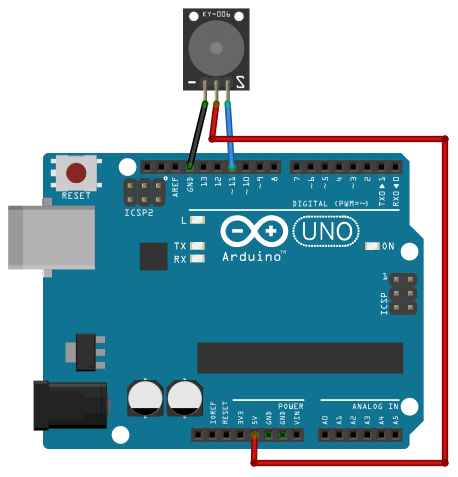
sketch#
void setup () {
pinMode (11, OUTPUT); // 11번 핀을 출력으로 설정
}
void loop () {
digitalWrite (11, HIGH); // 11번 핀 부저 ON
delay (1000);
digitalWrite (11, LOW); // 11번 핀 부저 OFF
delay (1000);
}과제#
tact 스위치를 누르면 액티브 부저 소리 울리기
Passive Buzzer 사용#
주파수#
- 0옥타브(C0
B0): 1631(Hz) (초저주파) - 1옥타브(C1
B1): 3362(Hz) - 2옥타브(C2
B2): 65123(Hz)- 중저음
- 3옥타브(C3
B3): 131247(Hz)- 기본 음계에 해당하는 옥타브
- 4옥타브(C4
B4): 262494(Hz)- 일반적으로 고음이라고 불리는 영역
- 일반적인 남자의 경우 G4~B4음이 최고음
- 음악의 기준음인 **가온 라(A4)(440Hz)**가 속한 영역
- 5옥타브(C5
B5): 523988(Hz)- 일반적인 여성의 경우 D5의 음까지는 낼 수 있고, 고음을 잘 내는 경우 E5까지는 무난함
- 6옥타브(C6
B6): 10471976(Hz) - 7옥타브(C7
B7): 20933951(Hz) - 8옥타브(C8
B8): 41867902(Hz) - 9옥타브(C9
B9): 837215804(Hz) - 10옥타브(C10
B10): 1674431608(Hz) (초음파)
한 옥타브 내려가면 주파수가 1/2배, 올라가면 2배가 되고, 한 음계 올라가면 2^(1/12) 배가 된다.
0옥타브 중간쯤(20Hz)부터나, 10옥타브 중간쯤(20kHz)부터는 소리가 들리지 않는다. 사람의 가청 영역을 벗어나기 때문. 이를 각각 초저주파, 초음파라고 한다. 어릴 수록 고음이 잘 들리기 때문에, “선생님은 못 듣는 벨소리"같은 것을 만들수 있다.
| 0 | 1 | 2 | 3 | 4 | 5 | 6 | 7 | 8 | |
|---|---|---|---|---|---|---|---|---|---|
| C(도) | 16 | 33 | 65 | 131 | 262 | 523 | 1046.5 | 2093 | 4186 |
| C♯ | 17 | 35 | 69 | 139 | 277 | 554 | 1109 | 2217.5 | 4435 |
| D(레) | 18 | 37 | 73 | 147 | 294 | 587 | 1175 | 2349 | 4699 |
| D♯ | 20 | 39 | 78 | 156 | 311 | 622 | 1244.5 | 2489 | 4978 |
| E(미) | 21 | 41 | 82 | 165 | 330 | 659 | 1318.5 | 2637 | 5274 |
| F(파) | 22 | 44 | 87 | 175 | 349 | 698.5 | 1397 | 2794 | 5588 |
| F♯ | 23 | 46 | 92.5 | 185 | 370 | 740 | 1480 | 2960 | 5920 |
| G(솔) | 25 | 49 | 98 | 196 | 392 | 784 | 1568 | 3136 | 6272 |
| G♯ | 26 | 52 | 104 | 208 | 415 | 831 | 1661 | 3322.5 | 6645 |
| A(라) | 28 | 55 | 110 | 220 | 440 | 880 | 1760 | 3520 | 7040 |
| A♯ | 29 | 58 | 116.5 | 233 | 466 | 932 | 1865 | 3729 | 7459 |
| B(시) | 31 | 62 | 123.5 | 247 | 494 | 988 | 1975.5 | 3951 | 7902 |
Pin Map#
| Arduino | Active Buzzer | Passive Buzzer |
|---|---|---|
| 11 | S | S |
| 5V | 표기없음 | 표기없음 |
| GND | (-) | (-) |
sketch : Passive Buzzer#
tone() 사용방법#
tone 함수는 3개의 매개변수(핀, 주파수, 음길이)를 사용하며, 마지막 매개변수(음길이)는 생략 가능하다.
tone(11, 262, 500); // 11번 핀에 연결된 부저에 C3음을 0.5초 연주마지막 매개변수를 사용하지 않고 tone을 연속으로 사용하는 경우 주의가 필요하다. 예를들어,
tone(11, 262); // 11번 핀에 연결된 부저에 C3음을 0.5초 연주 tone(11, 294); // 11번 핀에 연결된 부저에 D3음을 0.5초 연주이렇게 tone을 연속으로 사용하면 C3음을 소리낸 이후에, D4음을 내는 것이 아니라 C3음이 계속되므로, noTone함수를 사용하여 소리 출력을 멈추어야 한다.
tone(11, 262); // 11번 핀에 연결된 부저에 C3음을 0.5초 연주 noTone(11); tone(11, 294); // 11번 핀에 연결된 부저에 D3음을 0.5초 연주마지막 매개변수를 사용할 때, 중간에 음을 멈추는 구간을 만들려면, delay를 사용한다.
tone(11, 262, 500); // 11번 핀에 연결된 부저에 C3음을 0.5초 연주 delay(600); tone(11, 294, 500); // 11번 핀에 연결된 부저에 D3음을 0.5초 연주C3음을 0.5초 소리낸 후 delay(600) 에 의해 0.6초를 쉬는 것이 아니라, delay(600) 의 시간 중, 0.5초는 C3음을 소리내는 데 사용하고, 나머지 0.1초를 쉰다.
예시#
도레미파솔라시도#
const int BUZZER_PIN = 11;
const int C_4 = 261; // 도
const int D_4 = 294; // 레
const int E_4 = 330; // 미
const int F_4 = 349; // 파
const int G_4 = 392; // 솔
const int A_4 = 440; // 라
const int B_4 = 494; // 시
void setup() {
}
void loop() {
tone(BUZZER_PIN, C_4);
delay(500);
tone(BUZZER_PIN, D_4);
delay(500);
tone(BUZZER_PIN, E_4);
delay(500);
tone(BUZZER_PIN, F_4);
delay(500);
tone(BUZZER_PIN, G_4);
delay(500);
tone(BUZZER_PIN, A_4);
delay(500);
tone(BUZZER_PIN, B_4);
delay(500);
noTone(BUZZER_PIN);
}노래 연주: Super Mario Theme#
/* Arduino Mario Bros Tunes With Piezo Buzzer and PWM
by : ARDUTECH
Connect the positive side of the Buzzer to pin 11,
then the negative side to a 1k ohm resistor. Connect
the other side of the 1 k ohm resistor to
ground(GND) pin on the Arduino.
*/
#define NOTE_B0 31
#define NOTE_C1 33
#define NOTE_CS1 35
#define NOTE_D1 37
#define NOTE_DS1 39
#define NOTE_E1 41
#define NOTE_F1 44
#define NOTE_FS1 46
#define NOTE_G1 49
#define NOTE_GS1 52
#define NOTE_A1 55
#define NOTE_AS1 58
#define NOTE_B1 62
#define NOTE_C2 65
#define NOTE_CS2 69
#define NOTE_D2 73
#define NOTE_DS2 78
#define NOTE_E2 82
#define NOTE_F2 87
#define NOTE_FS2 93
#define NOTE_G2 98
#define NOTE_GS2 104
#define NOTE_A2 110
#define NOTE_AS2 117
#define NOTE_B2 123
#define NOTE_C3 131
#define NOTE_CS3 139
#define NOTE_D3 147
#define NOTE_DS3 156
#define NOTE_E3 165
#define NOTE_F3 175
#define NOTE_FS3 185
#define NOTE_G3 196
#define NOTE_GS3 208
#define NOTE_A3 220
#define NOTE_AS3 233
#define NOTE_B3 247
#define NOTE_C4 262
#define NOTE_CS4 277
#define NOTE_D4 294
#define NOTE_DS4 311
#define NOTE_E4 330
#define NOTE_F4 349
#define NOTE_FS4 370
#define NOTE_G4 392
#define NOTE_GS4 415
#define NOTE_A4 440
#define NOTE_AS4 466
#define NOTE_B4 494
#define NOTE_C5 523
#define NOTE_CS5 554
#define NOTE_D5 587
#define NOTE_DS5 622
#define NOTE_E5 659
#define NOTE_F5 698
#define NOTE_FS5 740
#define NOTE_G5 784
#define NOTE_GS5 831
#define NOTE_A5 880
#define NOTE_AS5 932
#define NOTE_B5 988
#define NOTE_C6 1047
#define NOTE_CS6 1109
#define NOTE_D6 1175
#define NOTE_DS6 1245
#define NOTE_E6 1319
#define NOTE_F6 1397
#define NOTE_FS6 1480
#define NOTE_G6 1568
#define NOTE_GS6 1661
#define NOTE_A6 1760
#define NOTE_AS6 1865
#define NOTE_B6 1976
#define NOTE_C7 2093
#define NOTE_CS7 2217
#define NOTE_D7 2349
#define NOTE_DS7 2489
#define NOTE_E7 2637
#define NOTE_F7 2794
#define NOTE_FS7 2960
#define NOTE_G7 3136
#define NOTE_GS7 3322
#define NOTE_A7 3520
#define NOTE_AS7 3729
#define NOTE_B7 3951
#define NOTE_C8 4186
#define NOTE_CS8 4435
#define NOTE_D8 4699
#define NOTE_DS8 4978
#define melodyPin 11
//Mario main theme melody
int melody[] = {
NOTE_E7, NOTE_E7, 0, NOTE_E7,
0, NOTE_C7, NOTE_E7, 0,
NOTE_G7, 0, 0, 0,
NOTE_G6, 0, 0, 0,
NOTE_C7, 0, 0, NOTE_G6,
0, 0, NOTE_E6, 0,
0, NOTE_A6, 0, NOTE_B6,
0, NOTE_AS6, NOTE_A6, 0,
NOTE_G6, NOTE_E7, NOTE_G7,
NOTE_A7, 0, NOTE_F7, NOTE_G7,
0, NOTE_E7, 0, NOTE_C7,
NOTE_D7, NOTE_B6, 0, 0,
NOTE_C7, 0, 0, NOTE_G6,
0, 0, NOTE_E6, 0,
0, NOTE_A6, 0, NOTE_B6,
0, NOTE_AS6, NOTE_A6, 0,
NOTE_G6, NOTE_E7, NOTE_G7,
NOTE_A7, 0, NOTE_F7, NOTE_G7,
0, NOTE_E7, 0, NOTE_C7,
NOTE_D7, NOTE_B6, 0, 0
};
//Mario main theme tempo
int tempo[] = {
12, 12, 12, 12,
12, 12, 12, 12,
12, 12, 12, 12,
12, 12, 12, 12,
12, 12, 12, 12,
12, 12, 12, 12,
12, 12, 12, 12,
12, 12, 12, 12,
9, 9, 9,
12, 12, 12, 12,
12, 12, 12, 12,
12, 12, 12, 12,
12, 12, 12, 12,
12, 12, 12, 12,
12, 12, 12, 12,
12, 12, 12, 12,
9, 9, 9,
12, 12, 12, 12,
12, 12, 12, 12,
12, 12, 12, 12,
};
//Underworld melody
int underworld_melody[] = {
NOTE_C4, NOTE_C5, NOTE_A3, NOTE_A4,
NOTE_AS3, NOTE_AS4, 0,
0,
NOTE_C4, NOTE_C5, NOTE_A3, NOTE_A4,
NOTE_AS3, NOTE_AS4, 0,
0,
NOTE_F3, NOTE_F4, NOTE_D3, NOTE_D4,
NOTE_DS3, NOTE_DS4, 0,
0,
NOTE_F3, NOTE_F4, NOTE_D3, NOTE_D4,
NOTE_DS3, NOTE_DS4, 0,
0, NOTE_DS4, NOTE_CS4, NOTE_D4,
NOTE_CS4, NOTE_DS4,
NOTE_DS4, NOTE_GS3,
NOTE_G3, NOTE_CS4,
NOTE_C4, NOTE_FS4, NOTE_F4, NOTE_E3, NOTE_AS4, NOTE_A4,
NOTE_GS4, NOTE_DS4, NOTE_B3,
NOTE_AS3, NOTE_A3, NOTE_GS3,
0, 0, 0
};
//Underwolrd tempo
int underworld_tempo[] = {
12, 12, 12, 12,
12, 12, 6,
3,
12, 12, 12, 12,
12, 12, 6,
3,
12, 12, 12, 12,
12, 12, 6,
3,
12, 12, 12, 12,
12, 12, 6,
6, 18, 18, 18,
6, 6,
6, 6,
6, 6,
18, 18, 18, 18, 18, 18,
10, 10, 10,
10, 10, 10,
3, 3, 3
};
void setup(void)
{
pinMode(melodyPin, OUTPUT); // buzzer
pinMode(13, OUTPUT); // led indicator when singing a note
}
void loop()
{
//sing the tunes
sing(1);
sing(1);
sing(2);
}
int song = 0;
void sing(int s) {
// iterate over the notes of the melody:
song = s;
if (song == 2) {
Serial.println(" 'Underworld Theme'");
int size = sizeof(underworld_melody) / sizeof(int);
for (int thisNote = 0; thisNote < size; thisNote++) {
// to calculate the note duration, take one second
// divided by the note type.
//e.g. quarter note = 1000 / 4, eighth note = 1000/8, etc.
int noteDuration = 1000 / underworld_tempo[thisNote];
buzz(melodyPin, underworld_melody[thisNote], noteDuration);
// to distinguish the notes, set a minimum time between them.
// the note's duration + 30% seems to work well:
int pauseBetweenNotes = noteDuration * 1.30;
delay(pauseBetweenNotes);
// stop the tone playing:
buzz(melodyPin, 0, noteDuration);
}
} else {
Serial.println(" 'Mario Theme'");
int size = sizeof(melody) / sizeof(int);
for (int thisNote = 0; thisNote < size; thisNote++) {
// to calculate the note duration, take one second
// divided by the note type.
//e.g. quarter note = 1000 / 4, eighth note = 1000/8, etc.
int noteDuration = 1000 / tempo[thisNote];
buzz(melodyPin, melody[thisNote], noteDuration);
// to distinguish the notes, set a minimum time between them.
// the note's duration + 30% seems to work well:
int pauseBetweenNotes = noteDuration * 1.30;
delay(pauseBetweenNotes);
// stop the tone playing:
buzz(melodyPin, 0, noteDuration);
}
}
}
void buzz(int targetPin, long frequency, long length) {
digitalWrite(13, HIGH);
long delayValue = 1000000 / frequency / 2; // calculate the delay value between transitions
//// 1 second's worth of microseconds, divided by the frequency, then split in half since
//// there are two phases to each cycle
long numCycles = frequency * length / 1000; // calculate the number of cycles for proper timing
//// multiply frequency, which is really cycles per second, by the number of seconds to
//// get the total number of cycles to produce
for (long i = 0; i < numCycles; i++) { // for the calculated length of time...
digitalWrite(targetPin, HIGH); // write the buzzer pin high to push out the diaphram
delayMicroseconds(delayValue); // wait for the calculated delay value
digitalWrite(targetPin, LOW); // write the buzzer pin low to pull back the diaphram
delayMicroseconds(delayValue); // wait again or the calculated delay value
}
digitalWrite(13, LOW);
}노래 연주: 학교종이 땡땡땡#
const int BUZZER_PIN = 11;
const int C_4 = 261; // 도
const int D_4 = 294; // 레
const int E_4 = 330; // 미
const int F_4 = 349; // 파
const int G_4 = 392; // 솔
const int A_4 = 440; // 라
const int B_4 = 494; // 시
typedef struct {
int tone;
unsigned long delay;
} TAD;//Tone And Delay
TAD music[] =
{
{G_4, 100}, {G_4, 100}, {A_4, 100}, {A_4, 100}, {G_4, 100}, {G_4, 100}, {E_4, 200},
{G_4, 100}, {G_4, 100}, {E_4, 100}, {E_4, 100}, {D_4, 200}, {G_4, 100}, {G_4, 100},
{A_4, 100}, {A_4, 100}, {G_4, 100}, {G_4, 100}, {E_4, 200}, {G_4, 100}, {E_4, 100},
{D_4, 100}, {E_4, 100}, {C_4, 200}
};
int musicLen;
void setup() {
musicLen = sizeof(music) / sizeof(TAD);
}
void loop() {
for(int i = 0; i < musicLen; i++) {
tone(BUZZER_PIN, music[i].tone);
delay(music[i].delay * 5);
noTone(BUZZER_PIN);
delay(30);
}
noTone(BUZZER_PIN);
delay(1000);
}과제#
- 크리스마스 캐롤 만들어보기
- 크리스마스 캐롤 연주시에, 음이 바뀔때마다 신호등 LED점멸 바꿔보기
미니 피아노 만들기#
패시브 부저와 스위치를 사용하여 미니 피아노를 만들어보자.
schematic#
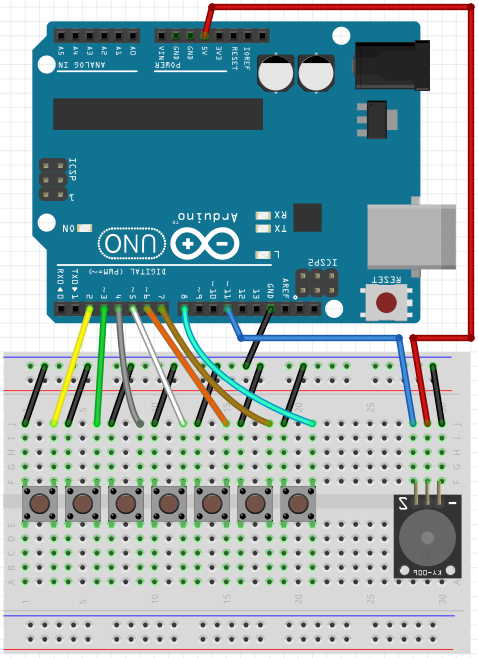
sketch#
const int BUZZER_PIN = 11;
// 도 레 미 파 솔 라 시
// C4 D4 E4 F4 G4 A4 B4
int octave_4[9] = {0, 0, 261, 294, 330, 349, 392, 440, 494};
void setup() {
// tact switch pin 2~8 for Keyboard
for(int i=2; i<=8; i++) {
pinMode(i, INPUT_PULLUP);
}
Serial.begin(9600);
}
void loop() {
for(int i=2; i<=8; i++) {
if(digitalRead(i) == HIGH) {
tone(BUZZER_PIN, octave_4[i]);
delay(1);
}
}
noTone(BUZZER_PIN);
}과제#
2명의 학생이 모여 2옥타브를 사용하는 피아노 연주곡 만들어보기